Tackling a brake job requires the right tools to ensure safety and efficiency. Whether you’re a DIY enthusiast or a professional mechanic, having proper equipment makes all the difference between a frustrating experience and a smooth repair process. The most essential tools for brake jobs include a quality socket set, torque wrench, and brake caliper tool, which together form the foundation of any successful brake repair.
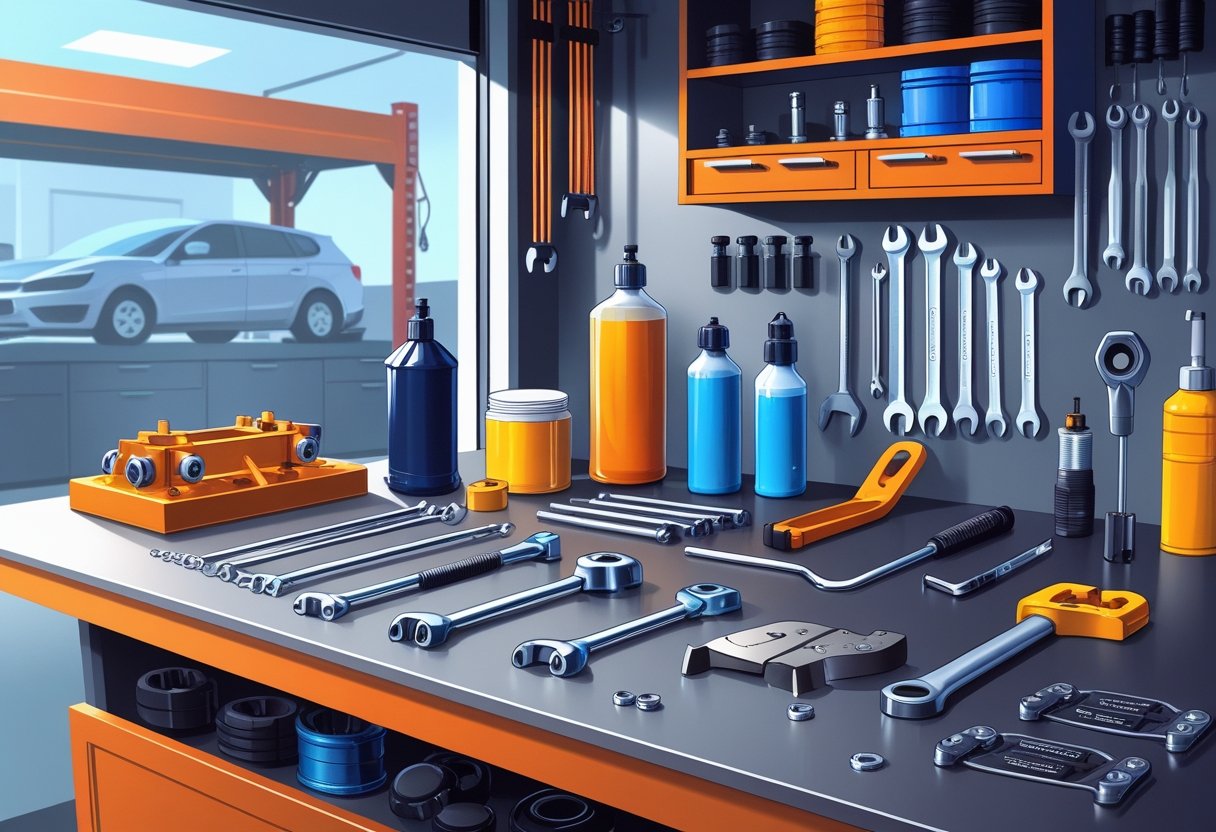
Brake work isn’t just about replacing pads and rotors. It involves careful inspection, precise adjustments, and thorough cleaning. Many mechanics find that specialty tools like brake spring pliers and brake line wrenches save significant time and prevent damage to components.
Key Takeaways
- A complete brake job toolkit should include both basic hand tools and specialty brake-specific tools for safety and efficiency.
- Proper diagnostic equipment helps identify brake system issues before beginning the repair process.
- Quality lifting equipment and safety gear are non-negotiable elements for performing brake work correctly.
Essential Hand Tools for Brake Jobs
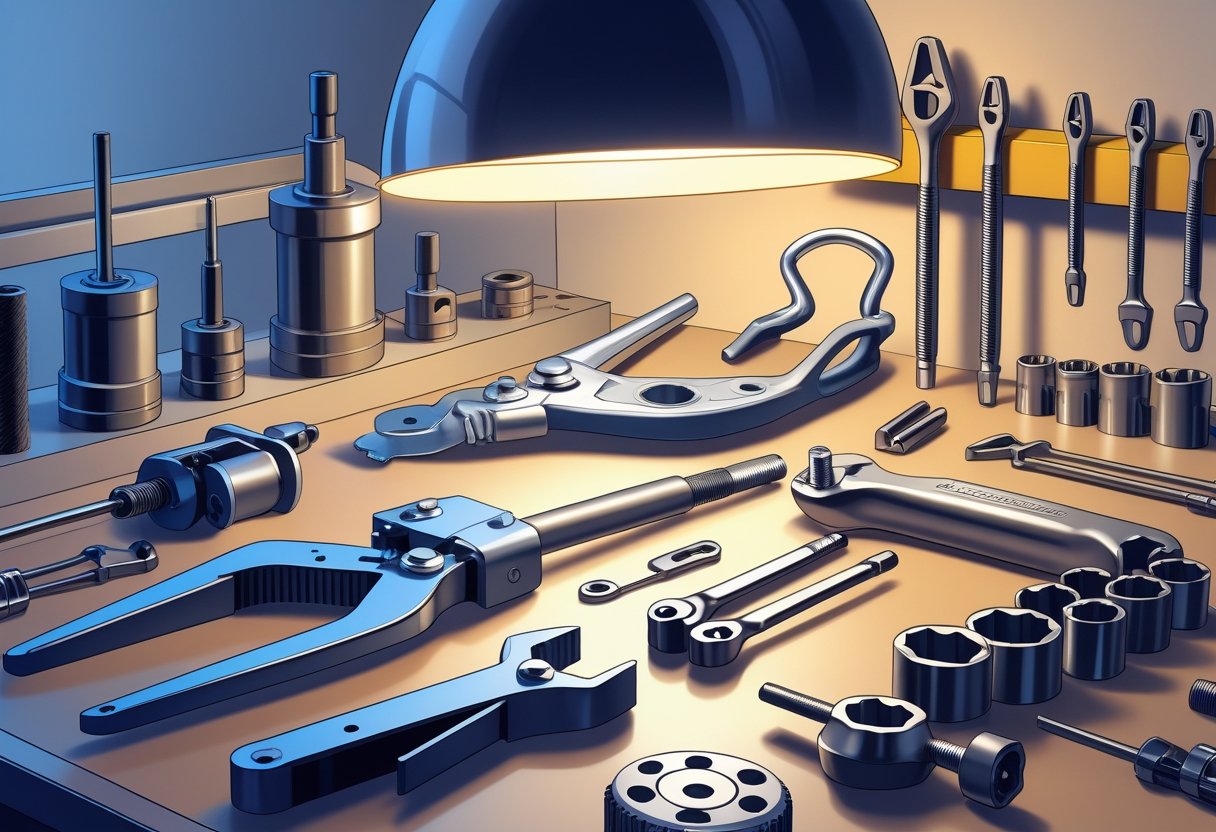
A successful brake job requires the right set of hand tools. Quality tools make the work safer, faster, and more precise when replacing or repairing brake components.
Wrenches and Ratchets
Combination wrenches and ratchets form the backbone of any brake toolkit. A set of metric and SAE combination wrenches (8mm to 19mm and 5/16″ to 3/4″) covers most brake caliper bolts and bleeder screws.
Ratchets with various drive sizes (1/4″, 3/8″, and 1/2″) provide the leverage needed for different tasks. The 3/8″ drive works best for most brake jobs, while 1/2″ helps with stubborn caliper bracket bolts.
Must-have wrench tools:
- Combination wrench set
- Torque wrench (calibrated to 20-100 ft-lbs)
- Breaker bar for stubborn bolts
- Ratcheting wrenches for tight spaces
A proper torque wrench is non-negotiable. Brake components require specific torque specifications for safety. Digital torque wrenches offer precision, while beam-style wrenches provide reliability at a lower cost.
Socket Sets
Socket sets in various sizes and depths are essential for accessing brake hardware. Both metric and standard sockets are necessary, with 10mm to 19mm covering most European and Asian vehicles.
Deep sockets can reach recessed bolts, particularly on caliper brackets. Six-point sockets provide better grip and reduce the chance of rounding off bolt heads compared to twelve-point options.
Common socket sizes for brake work:
| Vehicle Type | Common Socket Sizes |
|---|---|
| Domestic | 7/16″, 1/2″, 9/16″ |
| European | 13mm, 15mm, 17mm |
| Asian | 10mm, 12mm, 14mm |
Extensions and universal joints (swivels) help reach awkward angles behind brake assemblies. A set of impact sockets proves valuable when using air tools for stubborn caliper bracket bolts.
Screwdrivers
Both flathead and Phillips screwdrivers are necessary for brake jobs. A large flathead screwdriver works as a brake pad spreader tool in a pinch, while smaller screwdrivers help with removing and installing brake hardware clips.
Magnetic screwdrivers prevent small parts from falling into hard-to-reach areas. Having various lengths helps reach different components without removing additional parts.
Key screwdrivers for brake work:
- Large flathead (8″ or longer)
- Medium Phillips (#2)
- Stubby versions of both for tight spaces
- Magnetic tip options
Impact drivers with interchangeable bits can free seized screws on brake rotors and drums. These tools convert hammer strikes into rotational force, breaking loose corroded fasteners without damaging them.
Pliers
Different plier types make handling springs, clips, and other brake hardware much easier. Needle-nose pliers reach into tight spaces to retrieve or position small components and clips.
Channel-lock pliers provide adjustable grip strength for various tasks. Spring-loaded pliers specifically designed for brake hardware make quick work of retaining springs on drum brakes.
Brake line pliers feature specialized jaws for properly bending and flaring brake lines without crimping. Vise grips lock onto rounded-off bolts or stubborn bleeder screws that won’t turn with conventional wrenches.
Essential pliers for brake jobs:
Always clean pliers after use to prevent rust and keep the mechanisms working smoothly. Quality pliers last for decades when properly maintained.
Specialty Brake Tools
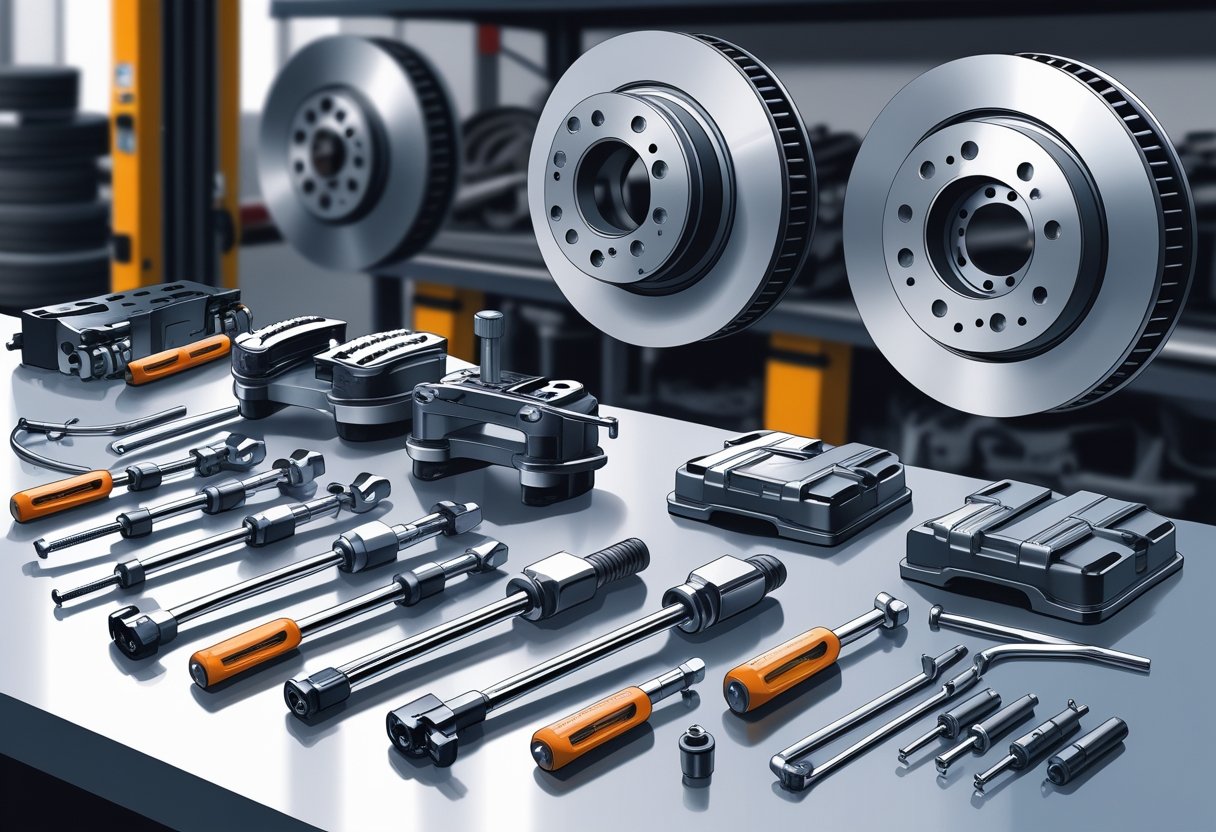
Working on brake systems requires specialized tools that make the job safer, faster, and more precise. These tools help mechanics access tight spaces, properly adjust components, and ensure brake systems function correctly after service.
Brake Caliper Tool
A brake caliper tool is essential for compressing caliper pistons when replacing brake pads. This specialized tool pushes the piston back into the caliper housing, creating enough clearance to fit new, thicker brake pads over the rotor.
Basic caliper tools use a simple screw mechanism to apply pressure. More advanced models feature a ratcheting system that provides better leverage with less effort.
For vehicles with rear disc brakes, look for caliper tools with multiple adapters. These rear calipers often require rotation while being compressed to avoid damaging the parking brake mechanism.
Key features to look for:
- Multiple adapters for different vehicle makes
- Comfortable grip handle
- Durable metal construction
- Smooth operation mechanism
Proper use of a caliper tool prevents damage to the caliper seals and pistons. Always clean the caliper thoroughly before compression to prevent contamination.
Brake Bleeder Kit
A brake bleeder kit removes air from the brake lines, ensuring proper brake pedal feel and performance. Air in the lines creates a spongy brake pedal and reduces stopping power.
Types of brake bleeding tools:
- One-person vacuum bleeders
- Pressure bleeders
- Two-person manual bleeder kits
- Electronic ABS bleeding tools
Vacuum bleeders use suction to draw fluid through the system. They allow one person to complete the job without assistance. Pressure bleeders connect to the master cylinder and push fluid through the system.
For basic brake jobs, a simple one-person vacuum bleeder works well. Professional mechanics often prefer pressure bleeders for their speed and efficiency.
Always use the correct bleeding sequence for your vehicle. Most require starting with the brake furthest from the master cylinder and working closer.
Brake Pad Spreader
Brake pad spreaders help mechanics properly position brake pads during installation. These simple tools ensure even contact between the pad and rotor surface.
A good brake pad spreader has a tapered design that gently pushes pads apart without damaging the friction material. Most are made from durable plastic to prevent scratching metal components.
Common uses include:
- Separating pads for easier installation
- Adjusting pad position after installation
- Checking clearance between pad and rotor
- Preventing damage to new pad material
For tight spaces, look for spreaders with long, narrow tips. Some models include measurement markings to help verify proper clearance.
Professional-grade spreaders often come in sets with different sizes and shapes. This variety allows mechanics to work on various brake systems from compact cars to heavy-duty trucks.
Diagnostic and Inspection Tools
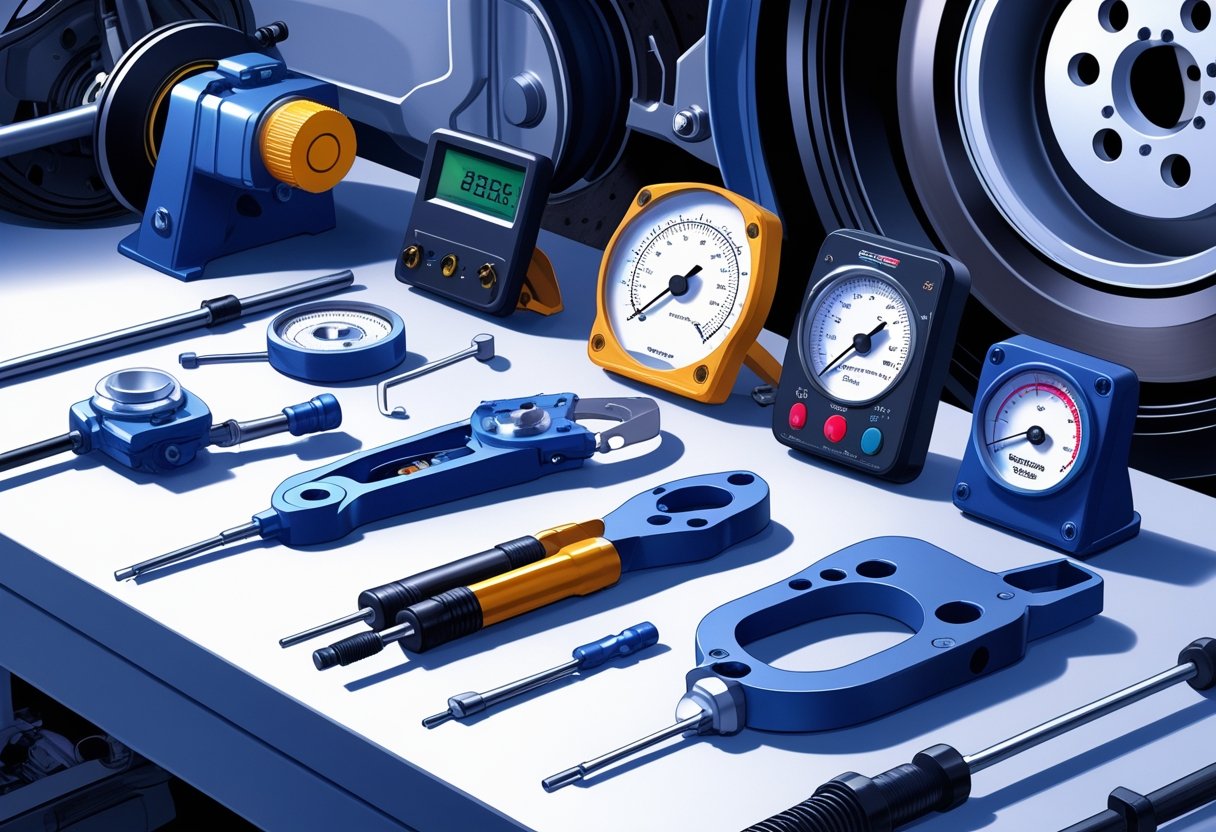
Properly diagnosing brake problems requires specialized tools that help mechanics identify issues before they become serious. These tools ensure accurate measurements and proper installation for safe brake operation.
Brake Fluid Tester
A brake fluid tester measures the moisture content and boiling point of brake fluid. Over time, brake fluid absorbs moisture, which lowers its boiling point and compromises braking performance.
Types of testers:
- Electronic testers (most accurate)
- Test strip indicators (budget-friendly)
- Refractometer tools (professional grade)
Most electronic testers display results through colored lights or digital readings. Green typically indicates good fluid, while yellow or red signals the need for replacement.
Professional mechanics recommend testing brake fluid every oil change or at least annually. Brake fluid with more than 3% moisture content should be replaced immediately.
Proper testing helps prevent brake fade, corrosion of internal components, and potential brake failure. This simple diagnostic step can identify problems before they affect safety.
Disc Thickness Gauge
A disc thickness gauge measures the remaining material on brake rotors. This precision tool helps determine if rotors need machining or replacement.
Most gauges feature:
- Micrometer-style measuring tips
- Easy-to-read scales (usually in millimeters)
- Ability to measure within 0.01mm accuracy
To use properly, clean the rotor surface first and measure at several points around the rotor. Most manufacturers specify minimum thickness requirements stamped directly on the rotor.
Measurements should be taken at the thinnest point of the rotor’s friction surface. A rotor that measures below the minimum specification must be replaced, not machined.
Many professional gauges also include specialized tips for measuring drum brake thickness. This versatility makes them essential for complete brake inspections.
Torque Wrench
A torque wrench ensures brake components are tightened to exact manufacturer specifications. Over-tightening can damage threads and components, while under-tightening can lead to parts loosening during operation.
Common torque wrench types:
- Click-type (makes audible click at preset torque)
- Beam-type (uses pointer and scale)
- Digital (provides precise electronic readout)
For brake work, a 3/8-inch drive torque wrench with a range of 10-80 ft-lbs covers most applications. Lug nuts typically require a 1/2-inch drive with higher torque capacity.
Always refer to vehicle-specific torque specifications. Caliper bolts, lug nuts, and brake line fittings each have unique torque requirements.
Store torque wrenches at their lowest setting to maintain calibration accuracy. Professional mechanics recommend annual calibration for tools used regularly.
Cleaning and Maintenance Supplies
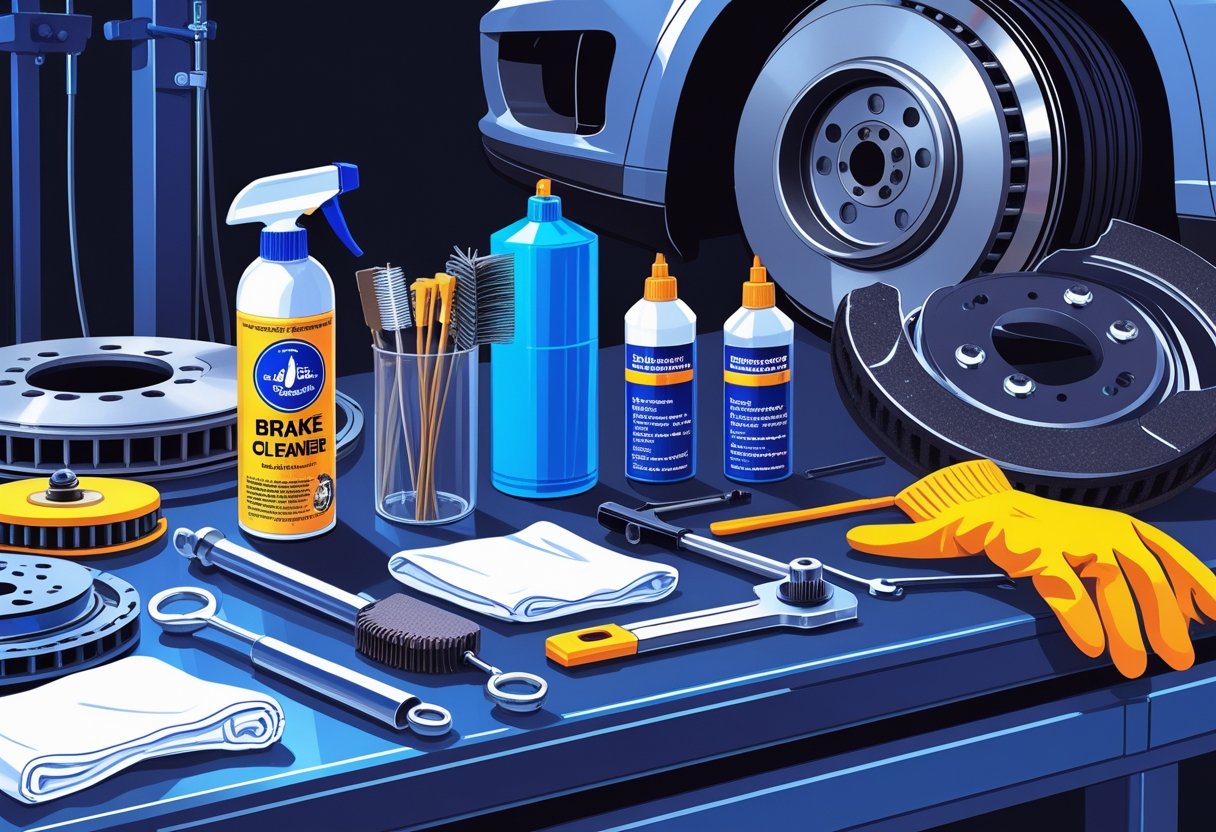
Proper cleaning is essential for any brake job. The right supplies ensure brake components work effectively and last longer.
Brake Cleaner
Brake cleaner is a powerful solvent that removes oil, grease, brake fluid, and dust from brake parts. It evaporates quickly without leaving residue, which is crucial for proper brake function.
Most brake cleaners come in aerosol cans with a directed spray nozzle for reaching tight spaces. Always choose a cleaner specifically designed for brakes, not general degreasers.
Types of brake cleaners:
- Chlorinated: More aggressive cleaning power
- Non-chlorinated: More environmentally friendly
When using brake cleaner, work in a well-ventilated area and wear protective gloves. Spray the cleaner directly onto contaminated parts and allow it to run off, carrying debris with it.
For stubborn grime, apply brake cleaner and scrub with a brush before rinsing with more cleaner.
Wire Brush
Wire brushes are indispensable for removing rust, corrosion, and stubborn brake dust from metal components.
Common wire brush types for brake work:
- Hand-held wire brushes
- Cup brushes (for power drills)
- Small detail brushes
The ideal wire brush has stiff bristles that can clean effectively without damaging brake components. Stainless steel bristles work best for most brake jobs.
When cleaning caliper brackets or rotor hats, use firm pressure and circular motions to remove built-up debris. For more delicate areas, choose a brass-bristled brush which is less likely to scratch surfaces.
After brushing, always follow up with brake cleaner to remove loosened particles before reassembly.
Lifting and Safety Equipment
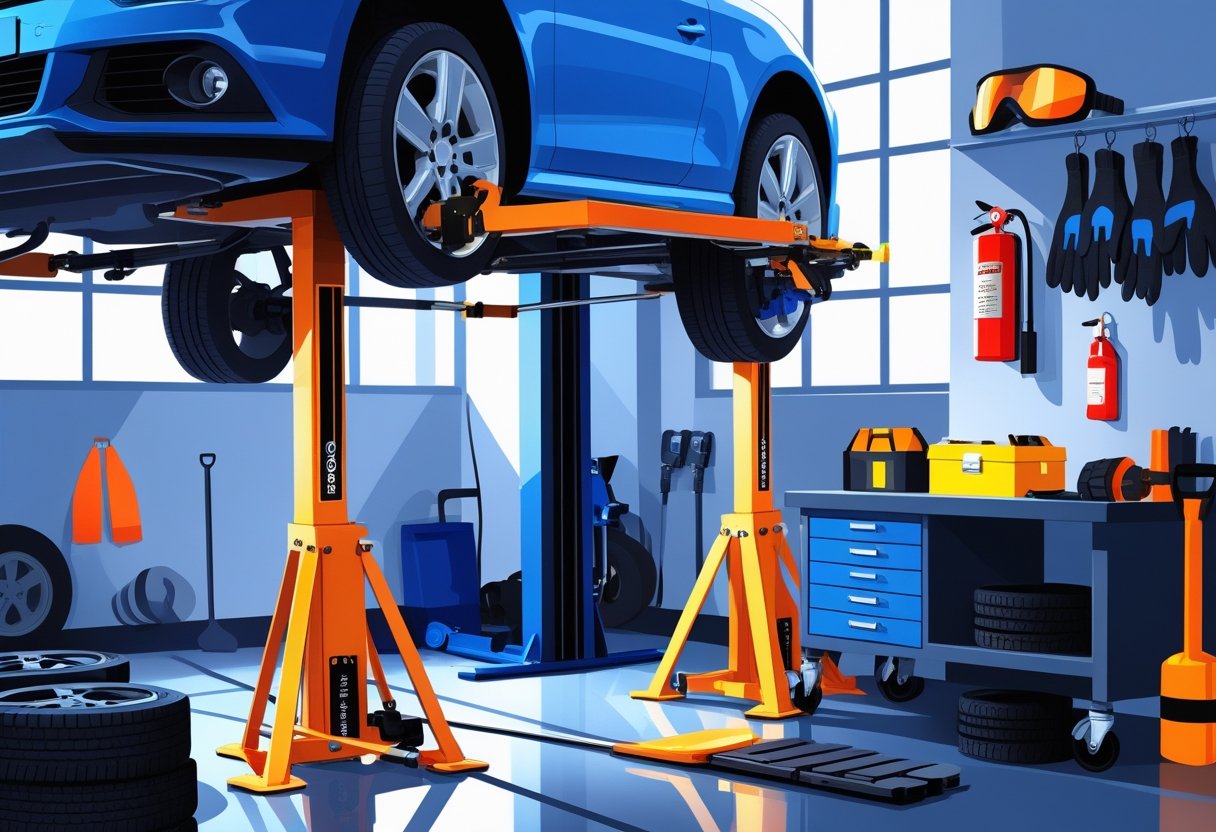
Safety should be your top priority when working on brakes. Using the right lifting and securing tools prevents accidents and injuries while providing proper access to brake components.
Jack and Jack Stands
A hydraulic floor jack is essential for lifting your vehicle safely. Choose one with sufficient weight capacity for your vehicle—most passenger cars require at least a 2-ton jack, while trucks and SUVs may need 3 tons or more.
Never rely on a jack alone to hold up your vehicle. Always use jack stands rated for your vehicle’s weight after lifting. Place jack stands under designated lift points on the frame or subframe.
For extra safety, leave the jack in place as a backup support even after the vehicle is on jack stands. Position the jack and stands on solid, level ground to prevent tipping or sinking.
Quality matters with these tools. Inexpensive jacks and stands may fail under load, creating dangerous situations.
Wheel Chocks
Wheel chocks prevent unexpected vehicle movement during brake work. These simple wedge-shaped blocks are placed against wheels that remain on the ground.
Always position chocks on both sides of wheels that aren’t being lifted. For automatic transmissions, place the vehicle in park; for manual transmissions, put it in gear before applying chocks.
Rubber chocks provide better grip on smooth garage floors. For steeper driveways or inclines, use heavier plastic or metal chocks with more aggressive teeth.
Some mechanics keep multiple sets of chocks for added security. This redundancy helps prevent the rare but dangerous situation of a vehicle rolling while being worked on.
Optional Advanced Tools
While basic tools handle most brake jobs, advanced tools can make your work more efficient and precise. These specialized tools help solve complex brake issues and produce professional-quality repairs.
Brake Lathe
A brake lathe resurfaces worn rotors and drums, saving money on replacement parts. Two main types exist: bench lathes for shop use and on-car lathes that mount directly to the vehicle’s hub.
Bench lathes provide precise cuts and can handle both rotors and drums. They require removing the component from the vehicle but often deliver superior finish quality.
On-car lathes resurface rotors while they remain mounted on the vehicle. This approach addresses runout issues that bench lathes might miss, as the rotor is cut exactly as it sits on the hub.
A quality brake lathe costs between $1,000-$3,000 but pays for itself over time. Many professional shops consider this tool essential for delivering quality brake service.
Scan Tool
Modern vehicles use electronic systems to monitor and control braking functions. A scan tool helps diagnose these complex systems when warning lights appear.
Basic scan tools ($100-$300) can read and clear ABS codes. Mid-range scanners ($300-$800) offer more detailed diagnostics and can access manufacturer-specific brake system data.
Professional-grade scanners ($1,000+) provide comprehensive access to all brake control modules. They can perform calibrations for advanced driver assistance systems (ADAS) that integrate with braking.
Some scan tools offer brake bleeding functions for vehicles with electronic brake systems. This feature is particularly useful for high-end vehicles with complex hydraulic systems.
Vehicles with electronic parking brakes absolutely require a scanner, as these systems must be put into service mode before replacing rear brake pads.
Storage and Organization for Brake Tools
Keeping brake tools organized saves time and prevents damage. A good storage system helps mechanics find what they need quickly and extends the life of their tools.
Toolboxes with multiple drawers work best for brake tools. Look for boxes with foam inserts that can be customized to hold specific tools. This prevents tools from moving around and getting damaged.
Wall storage options include pegboards and magnetic strips. These keep frequently used tools visible and within reach. Hanging heavier tools like brake spring pliers and calipers prevents damage that might occur in drawers.
Tool carts provide mobility when working on different vehicles. The best carts have locking wheels, multiple drawers, and a sturdy work surface on top.
Consider these organization categories:
| Category | Examples |
|---|---|
| Measurement Tools | Calipers, micrometers, gauges |
| Hand Tools | Wrenches, screwdrivers, pliers |
| Specialty Brake Tools | Caliper spreaders, pad spreaders |
| Consumables | Brake fluid, lubricants, cleaning supplies |
Label drawers and bins clearly for quick identification. Color-coding can help create a system where tools are easy to locate.
Store chemicals like brake cleaner separately from tools. These items should be kept in a ventilated area away from heat sources.
Regular cleaning of tools before storage prevents corrosion and contamination. Wipe tools down after each use and apply light oil to metal surfaces.